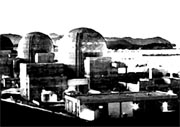Basking in nuclear power’s glow
Published: 28 Dec. 2009, 20:42

A few months later in March 1979, a nuclear reactor at the Three Mile Island Nuclear Generating Station in Pennsylvania, the United States, had a meltdown. It appeared as if Austria had foresight when closing their plant. Incidentally, the Carter administration of the United States had also declared it would stop constructing any new nuclear power plants. To make matters worse, in 1986 a nuclear reactor at the Chernobyl Nuclear Power Plant in Ukraine (then part of the Soviet Union) released a severe level of radioactivity. Many European countries began turning a cold shoulder to the idea of building nuclear power plants.
But France reacted differently. Placing the nuclear power generation company Framatome in charge, France built six Westinghouse model nuclear power plants in a row in 10 years. It was done with the assumption that France would eventually acquire the expertise to build a nuclear power plant on its own. In 1982, France even purchased the rights to use original nuclear energy technology from Westinghouse.
Japan, which surrendered in World War II after the United States dropped two atom bombs there, has promoted an active nuclear energy program since the 1950s.
South Korea has also constructed nuclear power plants one after another without hesitation. The godfather of Korea’s nuclear energy policy was President Syngman Rhee. The cradle of Korea’s nuclear energy development was the Central Training Center of the Korea Electric Power Corp. in Gongneung-dong, Nowon District, Seoul. Exactly 50 years ago, President Rhee established the Korea Atomic Energy Research Institute there. The experimental reactor built at that time is still there, and the Korea Institute of Radiological and Medical Sciences, the medical arm of the institute since separated from it, is located nearby.
As the antinuclear power movement, which lasted about 30 years, has subsided, nuclear power plants came into the spotlight again as a source of clean energy that is safe and does not produce greenhouse gases. Now, France, Japan and Korea have emerged as leading contenders in the market for nuclear power plant construction, which will eventually grow to trillions of dollars.
At last, Korea became an exporter of nuclear power plants by winning one of the world’s biggest nuclear energy contracts, a project for the construction of nuclear power plants for the United Arab Emirates. This is the valuable fruit of Korea’s 50-year effort to develop nuclear energy technology, including the sacrifices of the local residents who spent their careers working in nuclear power plants, the sweat of scientists and the dream of former presidents. I send a big round of applause to the people who worked hard to nurture Korea’s nuclear energy development.
*The writer is a deputy business news editor of the JoongAng Ilbo.
By Hoh Kui-seek










with the Korea JoongAng Daily
To write comments, please log in to one of the accounts.
Standards Board Policy (0/250자)